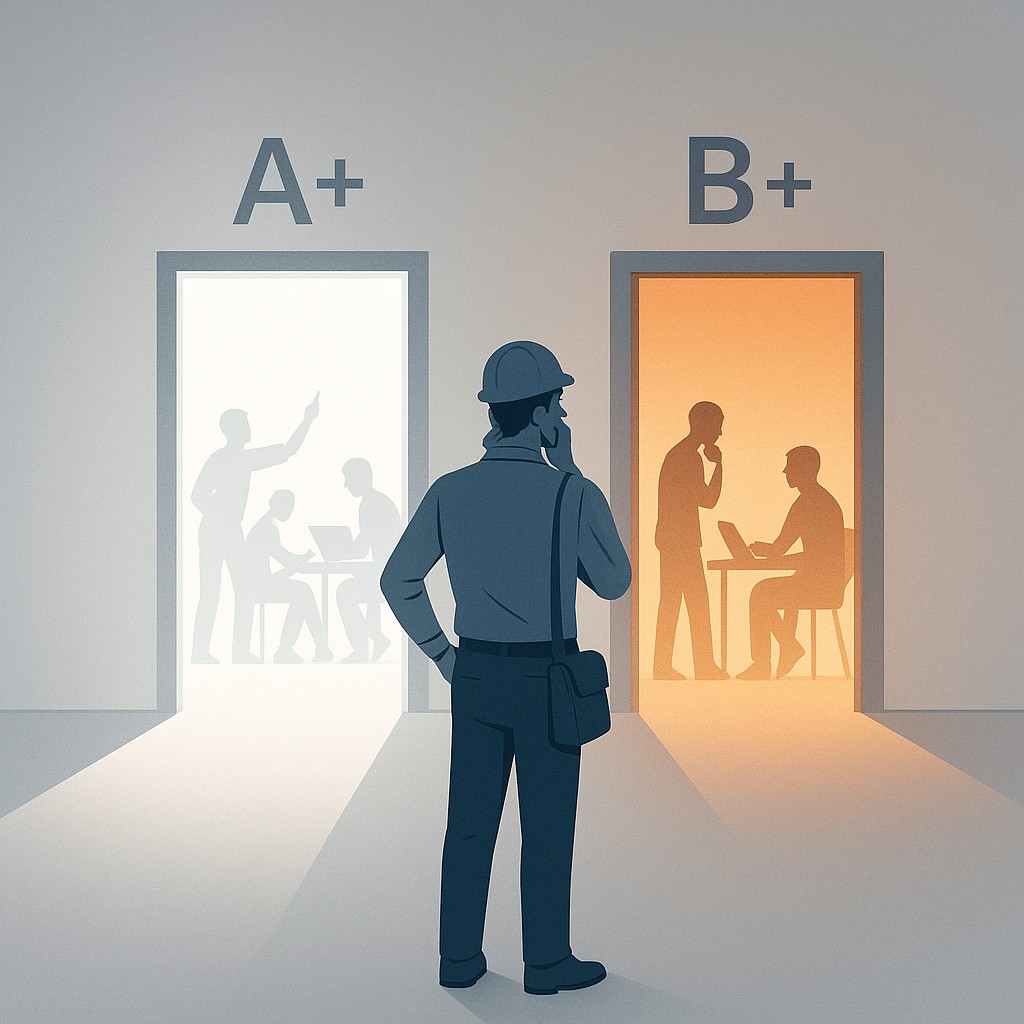Choose engineering team without burnout: excellence and empathy in staged growth
Choose engineering team without burnout: excellence and empathy in staged growth

The A+ vs B+ Team Trap—How to Choose an Engineering Team Without Burnout.
You’ve seen the Glassdoor posts. “Engineering team selection: A+ team with toxic culture or B+ team with great support?” It’s not just clickbait—it’s the real crossroads for ambitious engineers choosing A+ standards or support.
I’ve coached plenty of folks who landed right here, and honestly, I’ve been there myself. When you try to choose an engineering team without burnout, the pattern is easy to spot: prestige, pay, and fast-track promotions on the A+ team pull you in, but the constant push gets misread as toxicity. Meanwhile, the B+ team feels safe but people worry they’ll plateau. It sneaks up on you—one minute you’re learning, the next you’re stalled or burned out.

If I could start over, I’d still pick an A+ team straight out of the gate—for the standards, the lessons, the feeling of moving at “grown-up” speed. Not forever, just long enough to absorb the standard.
But here’s the trap. It’s so easy to fall into it—if you don’t intentionally avoid the prestige trap, you’ll tell yourself “one more promo, one more big launch,” until suddenly you’re fried, stuck, and nervous to jump somewhere else. I’ve watched it happen over and over, and done it myself more than once. You wake up exhausted and realize you can barely remember why you started.
Sometimes, I think back to that feeling of being in your first “real” engineering job, thinking every late-night deploy is a badge of honor. Then it’s two years in. You start measuring your weeks in how many fires you put out, not in what you built. I used to keep a list of “big wins” taped to my monitor, but after a while, it started gathering dust—too busy running to remember why I was running.
Here’s where this all leads. If you read on, I’ll show you how to craft moves for growth that actually last. You’ll see when to jump into A+ intensity, how to spot the turning point before you hit burnout, and how to bring those high standards with you into teams that know how to care for their people. Excellence and empathy can live in the same career. You just have to time the moves. Let’s get into the work.
How to Judge Growth vs Harm—A Framework You Can Trust
We talk a lot about discomfort in engineering. You’ll hear “get comfortable being uncomfortable” thrown around in onboarding docs or team retros. But discomfort vs toxicity are worlds apart—the stretch that grows you versus the pressure that quietly breaks you down. Discomfort is how you push your skills into new territory. Toxicity is when the grind keeps going until there’s not much left.
I keep coming back to this: productive discomfort offers a direct boost to performance, but strain from repeated challenge can actually drag results down over time. The trouble is, it’s way too easy to confuse the two—especially when you’re ambitious and willing to tough things out. The key question isn’t “am I uncomfortable?” It’s “is this pushing me beyond my limits, or just beyond where I’m comfortable?”
If you’re looking for signs things are working, start with the basics. Growth environments usually offer clear standards, direct and actionable feedback, stress you can recover from, and—this part matters—energy that actually returns after a day off. Remember, most folks will encounter destructive management at some point, but sustained exposure is less common—only a third see regular destructive behaviors. You’re not crazy if you’ve seen dysfunction, but being stretched doesn’t always mean you’re in harm’s way.
Quick tangent—I first learned to spot real risk while rock climbing, not in a meeting room. You’re taught to test your holds, trust your gear, and know the difference between being scared and actually being in danger. Once, I spent twenty minutes frozen on the wall because I wasn’t sure if the next grip would hold. All I could think about was how stupid it’d be to get hurt because I misread the rock.
Later, back at work, I realized I’d been ignoring those little alarms in my own career—just hoping the “next project” would feel safer, without checking if I was actually on steady ground. Over time, I realized that most growth is about controlled exposure: you want to be stretched enough that you learn, but never forced into doing something reckless for too long. Engineering isn’t climbing, but the judgment feels exactly the same.
Let’s talk about what actually signals toxicity, because intensity on its own gets a bad rap. Intensity with dignity and recovery is just drive in a strong team. The markers I watch for: disrespect from leads or teammates, management by fear, chronic sleep loss, and eroding psychological safety.
If you’re constantly worried you’ll be humiliated, punished, or your wellbeing keeps getting knowingly sacrificed, that’s not discomfort—it’s harm—and the move becomes spotting and exiting toxicity. I’ve coached engineers who blamed themselves for being “not tough enough” when really, recovery was impossible in their environment. Abusive supervision is a low base-rate reality, so don’t let a rare bad apple lead you to overgeneralize every stressful environment as toxic. Some folks need camaraderie to grow. Others thrive in the fire. The big thing is, intensity is only toxic when the fundamentals—respect, rest, and safety—are missing. You deserve to demand those basics.
Here’s how I keep it simple. Pick any 30–60 day window and set exit criteria by tracking just three things—your health, your motivation, and whether you’re actually learning. Each week, jot down the non-glamorous details. If you start dreading Mondays, your motivation tanks, and your health is worse than when you started, treat it as harm, not growth. This isn’t some big career audit. It’s a clear, heads-up check that actually works.
If you’re shipping code by day but need clean, AI-assisted writing fast, use our app to draft posts, docs, and updates that match your goals, constraints, and tone.
A Practical Blueprint for Sustainable Growth
If you want to choose an engineering team without burnout, you don’t learn world-class execution from blog posts or video tutorials. You learn it by being in the room with people who operate at that level. It’s the team’s daily rhythm—how code reviews happen in real time, how tough technical debates get settled, and what “done” actually means when stakes are high. Early exposure to this kind of rigor changes how you judge your own work. You start to see patterns in the way details are noticed, how tradeoffs are made under pressure, and what leaders pay attention to. Being surrounded by A+ standards imprints a clear sense of what excellence looks and feels like.
Enjoyed this post? For more insights on engineering leadership, mindful productivity, and navigating the modern workday, follow me on LinkedIn to stay inspired and join the conversation.
You can also view and comment on the original post here .
